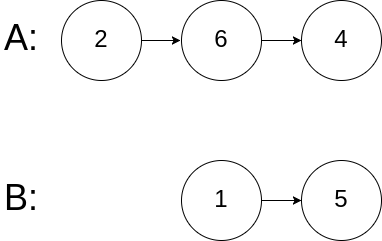*160. Intersection of Two Linked Lists
阿新 • • 發佈:2019-04-05
鏈表 分享 iteration null type span sam ack cycle
1. 原始題目
Write a program to find the node at which the intersection of two singly linked lists begins.
For example, the following two linked lists:

begin to intersect at node c1.
Example 1:

Input: intersectVal = 8, listA = [4,1,8,4,5], listB = [5,0,1,8,4,5], skipA = 2, skipB = 3 Output: Reference of the node with value = 8 Input Explanation: The intersected node‘s value is 8 (note that this must not be 0 if the two lists intersect). From the head of A, it reads as [4,1,8,4,5]. From the head of B, it reads as [5,0,1,8,4,5]. There are 2 nodes before the intersected node in A; There are 3 nodes before the intersected node in B.
Example 2:

Input: intersectVal = 2, listA = [0,9,1,2,4], listB = [3,2,4], skipA = 3, skipB = 1 Output: Reference of the node with value = 2 Input Explanation: The intersected node‘s value is 2 (note that this must not be 0 if the two lists intersect). From the head of A, it reads as [0,9,1,2,4]. From the head of B, it reads as [3,2,4]. There are 3 nodes before the intersected node in A; There are 1 node before the intersected node in B.
Example 3:

Input: intersectVal = 0, listA = [2,6,4], listB = [1,5], skipA = 3, skipB = 2 Output: null Input Explanation: From the head of A, it reads as [2,6,4]. From the head of B, it reads as [1,5]. Since the two lists do not intersect, intersectVal must be 0, while skipA and skipB can be arbitrary values. Explanation: The two lists do not intersect, so return null.
Notes:
- If the two linked lists have no intersection at all, return
null. - The linked lists must retain their original structure after the function returns.
- You may assume there are no cycles anywhere in the entire linked structure.
- Your code should preferably run in O(n) time and use only O(1) memory.
2. 題目理解
就是找兩個鏈表的交叉結點。註意:空鏈表;不存在交叉點的鏈表
3. 解題
思路:用兩個棧:依次將鏈表a和b分別進棧。然後出棧時比較兩個元素是否相等。如果遇到不同的結點,那麽該結點的上一個結點就是交叉節點。
1 # Definition for singly-linked list. 2 # class ListNode(object): 3 # def __init__(self, x): 4 # self.val = x 5 # self.next = None 6 7 class Solution(object): 8 def getIntersectionNode(self, headA, headB): 9 """ 10 :type head1, head1: ListNode 11 :rtype: ListNode 12 """ 13 if headA is None or headB is None: # 空鏈表處理 14 return None 15 results = None 16 stacka = [] 17 stackb = [] 18 a = headA 19 b = headB 20 while(a): # a進棧 21 stacka.append(a) 22 a = a.next 23 while(b): # b進棧 24 stackb.append(b) 25 b = b.next 26 27 i = -1 28 if stacka[i]!=stackb[i]: # 頭元素都不相等肯定沒有交叉點 29 return None 30 while (stacka[i]==stackb[i]): 31 i = i-1 32 if abs(i)>len(stacka) or abs(i)>len(stackb): 33 break 34 results = stacka[i+1] # 返回上一個結點 35 return results
當然我在Leetcode裏發現了更簡潔,漂亮的解法。如下:
# the idea is if you switch head, the possible difference between length would be countered.
# On the second traversal, they either hit or miss.
# if they meet, pa or pb would be the node we are looking for,
# if they didn‘t meet, they will hit the end at the same iteration, pa == pb == None, return either one of them is the same,None即遍歷到鏈表尾後就交換頭結點繼續遍歷。在第二次反轉時就會相遇或者錯過。如果相遇那麽該結點就是交叉點,錯過就是不存在交叉點。
1 class Solution: 2 # @param two ListNodes 3 # @return the intersected ListNode 4 def getIntersectionNode(self, headA, headB): 5 if headA is None or headB is None: 6 return None 7 8 pa = headA # 2 pointers 9 pb = headB 10 11 while pa is not pb: 12 # if either pointer hits the end, switch head and continue the second traversal, 13 # if not hit the end, just move on to next 14 pa = headB if pa is None else pa.next # 走到該鏈表末尾後下一步走另個鏈表開頭 15 pb = headA if pb is None else pb.next 16 17 return pa # only 2 ways to get out of the loop, they meet or the both hit the end=None
*160. Intersection of Two Linked Lists
